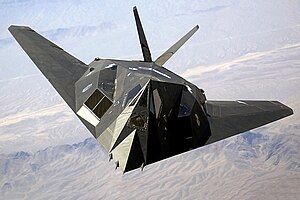
Back Sluipvliegtuig AF طائرة شبح Arabic Stels təyyarə AZ گیزلی اوچاق AZB স্টেল্থ Bengali/Bangla فڕۆکەی ڕادارڕەوێن CKB Stealth (fly) Danish Tarnkappenflugzeug German Avión furtivo Spanish هواگرد شناساگریز FA

Stealth aircraft are designed to avoid detection using a variety of technologies that reduce reflection/emission of radar, infrared,[1] visible light, radio frequency (RF) spectrum, and audio, collectively known as stealth technology.[2] The F-117 Nighthawk was the first operational aircraft explicitly designed around stealth technology. Other examples of stealth aircraft include the B-2 Spirit, the B-21 Raider, the F-22 Raptor,[3] the F-35 Lightning II,[4][5] the Chengdu J-20,[6] and the Sukhoi Su-57.
While no aircraft is completely invisible to radar, stealth aircraft make it more difficult for conventional radar to detect or track the aircraft effectively,[7] increasing the odds of an aircraft avoiding detection by enemy radar and/or avoiding being successfully targeted by radar guided weapons.[8] Stealth is a combination of passive low observable (LO) features and active emitters such as low-probability-of-intercept radars, radios and laser designators. These are typically combined with operational measures such as carefully planning mission maneuvers to minimize the aircraft's radar cross-section, since common hard turns or opening bomb bay doors can more than double an otherwise stealthy aircraft's radar return.[9] Stealth is accomplished by using a complex design philosophy to reduce the ability of an opponent's sensors to detect, track, or attack the stealth aircraft.[10] This philosophy takes into account the heat, sound, and other emissions of the aircraft which can also be used to locate it. Sensors are made to reduce the impact of low observable technologies and others have been proposed such as IRST (infrared search and track) systems to detect even reduced heat emissions,[11] long wavelength radars to counter stealth shaping and RAM focused on shorter wavelength radar,[12] or radar setups with multiple emitters to counter stealth shaping.[13] However these have disadvantages compared to traditional radar against non-stealthy aircraft.
Full-size stealth combat aircraft demonstrators have been flown by the United States (in 1977), Russia (in 2000) and China (in 2011).[14] As of December 2020[update], the only combat-ready stealth aircraft in service are the Northrop Grumman B-2 Spirit (1997), the Lockheed Martin F-22 Raptor (2005), the Lockheed Martin F-35 Lightning II (2015),[15][16] the Chengdu J-20 (2017),[17] and the Sukhoi Su-57 (2020),[18] with a number of other countries developing their own designs. There are also various aircraft with reduced detectability, either unintentionally or as a secondary feature.
In the 1999 NATO bombing of Yugoslavia two stealth aircraft were used by the United States, the veteran F-117 Nighthawk, and the newly introduced B-2 Spirit strategic stealth bomber. The F-117 performed its usual role of striking precision high-value targets and performed well, although one F-117 was shot down by a Serbian Isayev S-125 'Neva-M' missile brigade commanded by Colonel Zoltán Dani.
- ^ Cite error: The named reference
mahulikarwas invoked but never defined (see the help page). - ^ Cite error: The named reference
aeronauticalwas invoked but never defined (see the help page). - ^ "F-22 Raptor". U.S. Air Force (af.mil). Retrieved 7 August 2024.
- ^ "F-35A Lightning II". U.S. Air Force (af.mil). Retrieved 7 August 2024.
- ^ "F-35B Lightning II". Royal Air Force. Retrieved 7 August 2024.
- ^ Cite error: The named reference
csis_j-20was invoked but never defined (see the help page). - ^ FIREPOWER: THE WEAPONS THE PROFESSIONALS USE - AND HOW. SUPER FIGHTERS, #41 Orbis Publishing 1990
- ^ "They're Redesigning the Airplane", Micheal E. Long and James A. Sugar, National Geographic, January 1981, Vol. 159, No.1
- ^ Cite error: The named reference
nduwas invoked but never defined (see the help page). - ^ Cite error: The named reference
FAS.orgwas invoked but never defined (see the help page). - ^ Rogoway, Tyler (26 March 2015). "Infrared Search And Track Systems And The Future Of The US Fighter Force". Foxtrot Alpha. Retrieved 7 March 2019.
- ^ Axe, David (12 July 2016). "Did Russia's New Radar Just Make America's Lethal Stealth Fighters Obsolete?". The National Interest. Retrieved 7 March 2019.
- ^ Tao Yue (30 November 2001). "Scouting For Surveillance: Detection of the B-2 Stealth Bomber And a Brief History on 'Stealth'". The Tech. Archived from the original on 10 June 2009. Retrieved 7 March 2019.
- ^ Cite error: The named reference
aerosocietychannelwas invoked but never defined (see the help page). - ^ "5th Generation Fighters". Lockheed Martin. Archived from the original on 9 January 2010. Retrieved 15 April 2009.
- ^ "Marines Declare F-35B Operational, But Is It Really Ready For Combat?". Foxtrot Alpha. Archived from the original on 4 March 2018. Retrieved 4 March 2018.
- ^ "With the J20 stealth fighter in fully operation service, China leaps ahead in Asian arms race". Australian News. 20 October 2017. Archived from the original on 26 February 2018. Retrieved 4 March 2018.
- ^ "Первый серийный истребитель Су-57 поступил в авиаполк Южного военного округа".